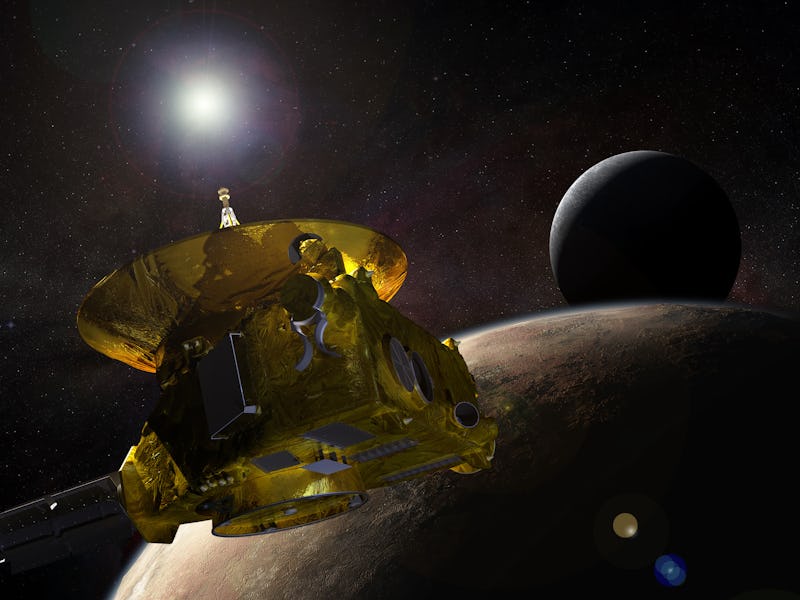NASA's Pluto mission just hit a major milestone
New Horizons is going where few spacecraft have gone before.

Alan Stern, the principal investigator for one of NASA’s most audacious missions, says this weekend is almost a holiday. “Saturday is like a birthday.”
“But it's more like in your car when the odometer turns some big round numbers, let's say 100,000 kilometers,” Stern tells Inverse.
Stern, New Horizons’ principal investigator, has watched the spacecraft venture further out into the outer Solar System since it launched toward Pluto and points beyond in 2006 and says this old spacecraft still has billions of miles left in it.
NASA’s New Horizons mission is preparing to pass a major milestone on its way to interstellar space. To paraphrase Star Trek, the probe will go where few missions have gone before — past a distance that’s 50 times as far away from the Sun as Earth.
Achieving this distance is no ordinary feat. Prior to New Horizons, only four spacecraft — Pioneer 10, Pioneer 11, Voyager 1, and Voyager 2 — were able to go that far. It’s a distance so vast that the Sun will appear to be smaller than the planet Jupiter from Earth.
The craft was the first to encounter the Pluto system, flying within 7,800 miles of it in 2015. It then moved on to the object Arrokath (previously called 2014 MU69) before continuing on its journey away from Earth. It has made some observations of the outer solar system and points beyond in that time.
Alice Bowman, the mission’s operations manager, says that they are constantly searching for new targets for New Horizons to explore.
“We’re looking for our next flyby target,” Bowman tells Inverse. “Our scientists will look for objects that are in the path of where the spacecraft is going.”
But in the meantime, it will cross a more metaphorical milestone: On April 17, New Horizons will be 50 astronomical units (AU) away from the Sun, or 50 times the distance from the Sun to the Earth. That’s almost 5 billion miles away.
At that distance, the view of the Sun from the spacecraft will appear as though the giant star is smaller than Jupiter. And the mission team members expect the spacecraft to keep going, reaching about twice as much that distance by the mid-2030s. The craft will eventually enter interstellar space and leave the Solar System entirely.
What are the goals of the New Horizons mission?
New Horizons launched on January 19, 2006, and reached its prime target Pluto in July 2015.
This colored map of Pluto was produced by the New Horizons camera during the spacecraft’s close flyby in 2015.
The dwarf planet is about 3 billion miles away from Earth, located in the mysterious Kuiper Belt. The Kuiper Belt is a doughnut-shaped disc of icy objects in the outer Solar System, and the source of many of the comets that swing past the Sun.
After conducting a six-month flyby study of Pluto, New Horizons ventured deeper into the Kuiper Belt to explore other planetary objects which are believed to be cosmic leftovers from planetary formation billions of years ago.
“There are more of these Pluto-like planets than there are giant planets and rocky planets combined,” Stern says. “The National Academy of Science considered it essential to begin to explore this most populous class of planets that had previously been ignored because we didn't know that there were so many.”
Built like no other — In order to explore these objects, New Horizons had to be built with a nuclear battery to provide power as opposed to solar arrays since the sunlight is too weak at that distance. The spacecraft’s communication system also had to be carefully designed so that it could send and receive data at that distance.
The spacecraft’s hardware is so strong, in fact, that it will likely outlast the software.
New Horizons is expected to last for another 15 years, and reach twice its current distance from the Sun.
If the scientists only spot one target to go next, then it’s an easy decision. However, if it’s more than one, then the scientists will look at the characteristics of that object and make a decision on which one to choose.
“We're making scientific observations all the time, 365 days a year,” Stern says. “And Saturday will be no different in that respect. It's just an occasion.”
But also, it’s still a reason to celebrate.
This article was originally published on